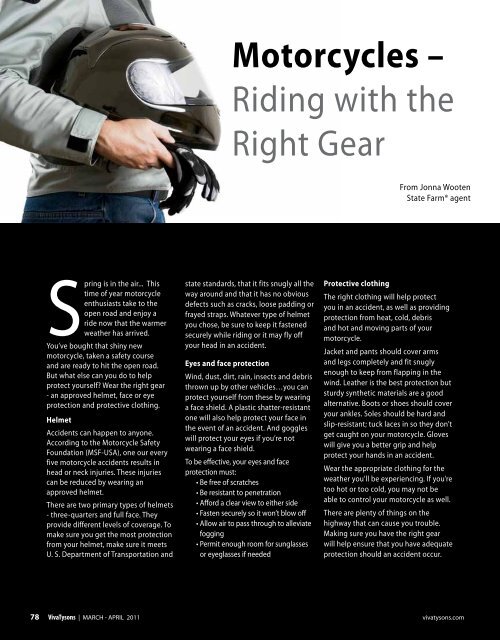March-April - Viva Tysons Magazine
March-April - Viva Tysons Magazine
March-April - Viva Tysons Magazine
Create successful ePaper yourself
Turn your PDF publications into a flip-book with our unique Google optimized e-Paper software.
78<br />
Spring is in the air... This<br />
time of year motorcycle<br />
enthusiasts take to the<br />
open road and enjoy a<br />
ride now that the warmer<br />
weather has arrived.<br />
You’ve bought that shiny new<br />
motorcycle, taken a safety course<br />
and are ready to hit the open road.<br />
But what else can you do to help<br />
protect yourself? Wear the right gear<br />
- an approved helmet, face or eye<br />
protection and protective clothing.<br />
helmet<br />
Accidents can happen to anyone.<br />
According to the Motorcycle Safety<br />
Foundation (MSF-USA), one our every<br />
five motorcycle accidents results in<br />
head or neck injuries. These injuries<br />
can be reduced by wearing an<br />
approved helmet.<br />
There are two primary types of helmets<br />
- three-quarters and full face. They<br />
provide different levels of coverage. To<br />
make sure you get the most protection<br />
from your helmet, make sure it meets<br />
U. S. Department of Transportation and<br />
Motorcycles –<br />
Riding with the<br />
Right Gear<br />
state standards, that it fits snugly all the<br />
way around and that it has no obvious<br />
defects such as cracks, loose padding or<br />
frayed straps. Whatever type of helmet<br />
you chose, be sure to keep it fastened<br />
securely while riding or it may fly off<br />
your head in an accident.<br />
Eyes and face protection<br />
Wind, dust, dirt, rain, insects and debris<br />
thrown up by other vehicles…you can<br />
protect yourself from these by wearing<br />
a face shield. A plastic shatter-resistant<br />
one will also help protect your face in<br />
the event of an accident. And goggles<br />
will protect your eyes if you’re not<br />
wearing a face shield.<br />
To be effective, your eyes and face<br />
protection must:<br />
• Be free of scratches<br />
• Be resistant to penetration<br />
• Afford a clear view to either side<br />
• Fasten securely so it won’t blow off<br />
• Allow air to pass through to alleviate<br />
fogging<br />
• Permit enough room for sunglasses<br />
or eyeglasses if needed<br />
From Jonna Wooten<br />
State Farm® agent<br />
Protective clothing<br />
The right clothing will help protect<br />
you in an accident, as well as providing<br />
protection from heat, cold, debris<br />
and hot and moving parts of your<br />
motorcycle.<br />
Jacket and pants should cover arms<br />
and legs completely and fit snugly<br />
enough to keep from flapping in the<br />
wind. Leather is the best protection but<br />
sturdy synthetic materials are a good<br />
alternative. Boots or shoes should cover<br />
your ankles. Soles should be hard and<br />
slip-resistant; tuck laces in so they don’t<br />
get caught on your motorcycle. Gloves<br />
will give you a better grip and help<br />
protect your hands in an accident.<br />
Wear the appropriate clothing for the<br />
weather you’ll be experiencing. If you’re<br />
too hot or too cold, you may not be<br />
able to control your motorcycle as well.<br />
There are plenty of things on the<br />
highway that can cause you trouble.<br />
Making sure you have the right gear<br />
will help ensure that you have adequate<br />
protection should an accident occur.<br />
<strong>Viva</strong><strong>Tysons</strong> | MARCH - APRIL 2011 vivatysons.com




